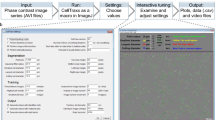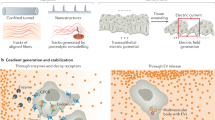Abstract
Characterizing the migration of a population of cells remains laborious and somewhat subjective. Advances in genetics and robotics allow researchers to perform many experiments in parallel, but analyzing the large sets of data remains a bottleneck. Here we describe a rapid, fully automated correlation-based method for cell migration analysis, compatible with standard video microscopy. This method allows for the computation of quantitative migration parameters via an extensive dynamic mapping of cell displacements.
This is a preview of subscription content, access via your institution
Access options
Subscribe to this journal
Receive 12 print issues and online access
$259.00 per year
only $21.58 per issue
Buy this article
- Purchase on Springer Link
- Instant access to full article PDF
Prices may be subject to local taxes which are calculated during checkout


Similar content being viewed by others
References
Liang, C.-C., Park, A.Y. & Guan, J.-L. Nat. Protoc. 2, 329–333 (2007).
Simpson, K.J. et al. Nat. Cell Biol. 10, 1027–1038 (2008).
Vitorino, P. & Meyer, T. Genes Dev. 22, 3268–3281 (2008).
Yarrow, J.C., Perlman, Z.E., Westwood, N.J. & Mitchison, T.J. BMC Biotechnol. 4, 21 (2004).
Ridley, A.J. et al. Science 302, 1704–1709 (2003).
Bai, S.W. et al. BMC Biol. 9, 54 (2011).
Zaritsky, A. et al. PLoS ONE 6, e27593 (2011).
Huth, J. et al. BMC Cell Biol. 11, 24 (2010).
Hand, A.J., Sun, T., Barber, D.C., Hose, D.R. & MacNeil, S. J. Microsc. 234, 62–79 (2009).
Petitjean, L. et al. Biophys. J. 98, 1790–1800 (2010).
Angelini, T.E. et al. Proc. Natl. Acad. Sci. USA 108, 4714–4719 (2011).
Supatto, W. et al. Proc. Natl. Acad. Sci. USA 102, 1047–1052 (2005).
Raffel, M., Willert, C.E. & Kompenhans, J. Particle Image Velocimetry: A Practical Guide (Springer, Berlin, 1998).
Hamad, N.M. et al. Genes Dev. 16, 2045–2057 (2002).
Takenawa, T. & Suetsugu, S. Nat. Rev. Mol. Cell Biol. 8, 37–48 (2007).
Farooqui, R. & Fenteany, G. J. Cell Sci. 118, 51–63 (2005).
Hahn, W.C. et al. Nature 400, 464–468 (1999).
Kasai, H., Allen, J.T., Mason, R.M., Kamimura, T. & Zhang, Z. Respir. Res. 6, 56 (2005).
Rasband, W.S. ImageJ v1.46b <<http://rsb.info.nih.gov/ij/> (US National Institutes of Health, Bethesda, Maryland, –1997–2012).
Sveen, J.K. An introduction to MatPIV (Mechanics and Applied Mathematics no. 2) <http://folk.uio.no/jks/matpiv/> (Department of Math, University of Oslo, 2004).
Acknowledgements
It's a pleasure to thank L. Selfors, K. Simpson and J. Brugge (Harvard University) for giving us full access to their data. We thank A. Gautreau (Laboratoire d'Enzymologie et de Biologie Structurale, Gif-sur-Yvette) for the gift of the anti-Wave2 antibody, J.K. Sveen for fruitful discussions and H. Yevick for a critical reading of the manuscript. Financial support from the Association pour la Recherche sur le Cancer, the Agence Nationale de la Recherche (project IntegRal), the Association Christelle Bouillot, the Ligue Contre le Cancer and the Institut Curie Program 'Modèles Cellulaires' is gratefully acknowledged.
Author information
Authors and Affiliations
Corresponding authors
Ethics declarations
Competing interests
The authors declare no competing financial interests.
Supplementary information
Supplementary Text and Figures
Supplementary Figures 1–9, Supplementary Tables 1 and 2 and Supplementary Discussions 1 and 2 (PDF 1789 kb)
Supplementary Software
AVeMap source code. (ZIP 1060 kb)
HEK control.
Wound-healing with control HEK-HT cells. Total film duration: 16 h. Acquisitions were made every 15 min. Images were acquired in phase-contrast mode. Total width of the observation field = 1.68 mm. (MOV 5112 kb)
HEK siWave2 (5 nM).
Wound-healing with HEK-HT cells depleted of Wave2 (siRNA concentration of 5 nM). Total film duration: 16 h. Acquisitions were made every 15 min. Images were acquired in phase-contrast mode. Total width of the observation field = 1.68 mm. (MOV 5360 kb)
HEK siWave2 (2 nM).
Wound-healing with HEK-HT cells depleted of Wave2 (siRNA concentration of 2 nM). Total film duration: 16 h. Acquisitions were made every 15 min. Images were acquired in phase-contrast mode. Total width of the observation field = 1.68 mm. (MOV 8705 kb)
A549 control.
Wound-healing with A549 cells. Total film duration: 16 h. Acquisitions were made every 15 min. Images were acquired in phase-contrast mode. Total width of the observation field = 1.68 mm. (MOV 5256 kb)
A549 TGF-β.
Wound-healing with A549 cells in the presence of TGF-β. Total film duration: 16 h. Acquisitions were made every 15 min. Images were acquired in phase-contrast mode. Total width of the observation field = 1.68 mm. (MOV 6858 kb)
Rights and permissions
About this article
Cite this article
Deforet, M., Parrini, M., Petitjean, L. et al. Automated velocity mapping of migrating cell populations (AVeMap). Nat Methods 9, 1081–1083 (2012). https://doi.org/10.1038/nmeth.2209
Received:
Accepted:
Published:
Issue Date:
DOI: https://doi.org/10.1038/nmeth.2209
This article is cited by
-
Local light-activation of the Src oncoprotein in an epithelial monolayer promotes collective extrusion
Communications Physics (2019)
-
T cell migration in microchannels densely packed with T cells
Scientific Reports (2019)
-
Material approaches to active tissue mechanics
Nature Reviews Materials (2018)
-
Fibroblast growth factor 23 weakens chemotaxis of human blood neutrophils in microfluidic devices
Scientific Reports (2017)
-
Topological defects in confined populations of spindle-shaped cells
Nature Physics (2017)



